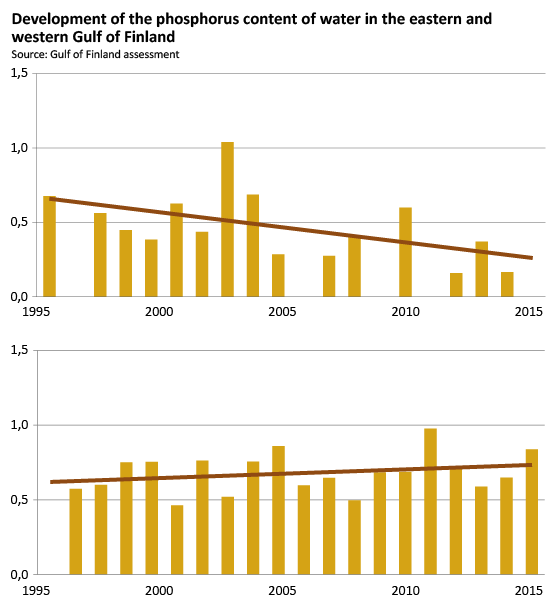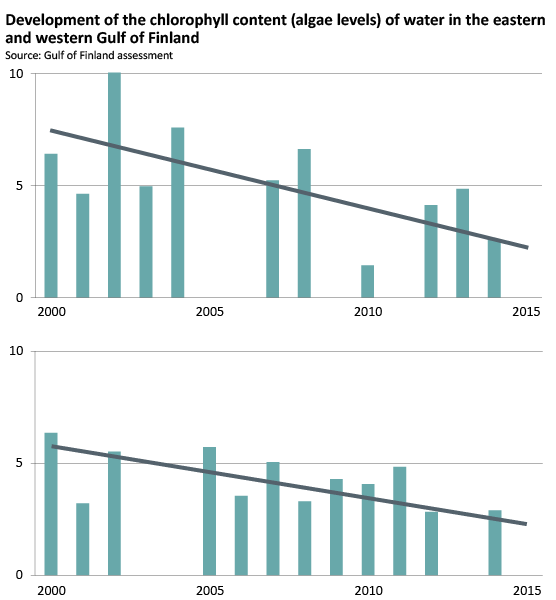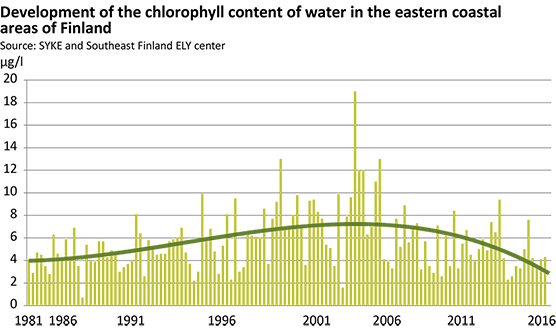Press release 2016-09-02 at 10:05
The Finnish Environment Institute SYKE has published an assessment of the Gulf of Finland, compiling the research results of over a hundred Finnish, Russian and Estonian researchers. The over 300-page publication includes recent information on issues such as eutrophication, hazardous substances, invasive species, noise, maritime traffic, and plastic waste. The publication is the most important result of the Gulf of Finland Year arranged by the countries.
The publication includes for the first time a comprehensive collection of material on the status of the Gulf of Finland over a long period of time, collected by the three countries. Methods of collecting and analysing data were compared during the project. It makes it possible to gain commensurate, reliable information on the status of the Gulf of Finland.

Development of the phosphorus content of water in the eastern coastal areas of Finland (Source: Gulf of Finland assessment) © SYKE
The Gulf of Finland recovers in the east, Russia has cut down emissions
The eutrophication in the easternmost parts of the Gulf of Finland has decreased, which is due to the decreased external nutrient load. An important reason for this is the emission reductions by Russia. The improved situation is visible as clearer waters in the eastern Gulf of Finland.
When moving west, the effect of the Baltic Proper on the status of the Gulf of Finland increases. In the western Gulf of Finland, the phosphorus content of the water has been influenced in particular by the flow of deep water from the Baltic Proper and the poor oxygen conditions in the area. The currents bring oxygen-poor water with high salinity and nutrient content into the Gulf, which slows down the recovery of the western Gulf of Finland. The effect of the Baltic Proper on the phosphorus content of the waters of the western Gulf of Finland is much greater than that of the nutrient load from the land. Therefore, improving the status of the Gulf of Finland requires actions throughout the area of the Baltic Proper.

Development of the chlorophyll content (algae levels) in the eastern and western Gulf of Finland (Source: Gulf of Finland assessment) © SYKE

Development of the chlorophyll content of water in the eastern coastal areas of Finland © Seppo Knuuttila, SYKE and Southeast Finland ELY Center
Researchers are increasingly concerned about the littering of sea areas, microplastics in particular. Finland and Estonia are monitoring littering on the shores for the fifth year in running. Currently, the monitoring in the Gulf of Finland includes seven shores.
Based on the monitoring and the assessment on the Gulf of Finland, up to 90% of the litter on the shores of the Gulf of Finland consists of plastic. The result is consistent with international research. The Finnish Environment Institute SYKE continues to monitor the amount of microlitter that is not visible to the naked eye in the open sea areas of the Gulf of Finland. In addition, the emission sources and how the microlitter migrates from water treatment plants to the sea will be investigated more thoroughly.
The Gulf of Finland needs action
A number of recommendations for improving the condition of the Gulf of Finland have been collected in the publication. They concern issues such as decreasing the nutrient load, reducing the risks of dredging and maritime traffic, improving the preconditions for fishing, and developing sea use planning, where the amount and effects of underwater noise is one of the rising research topics.
The research and monitoring of the status of the Gulf of Finland will continue in cooperation between the countries, supported by the proclamation promoting cooperation in the protection of the Gulf of Finland until 2020, issued by the Ministers of the Environment of the countries. Based on the publication ‘Suomenlahden tila’ (The state of the Gulf of Finland), a joint action plan, or a roadmap, has been drawn up by the three countries. The researchers update the recommendations for improving the status of the marine environment in the Gulf of Finland in the roadmap for decision-making.
Assessment
Images
See also
Further information
Publication ‘Suomenlahden tila’ (The state of the Gulf of Finland)
Senior Research Scientist Mika Raateoja
tel. +358 295 251 536, firstname.lastname@ymparisto.fi
Gulf of Finland cooperation between Finland, Estonia and Russia
Leading Researcher Kai Myrberg, Project Coordinator for the Gulf of Finland Year 2014,
tel. +358 295 251 441, firstname.lastname@ymparisto.fi
Senior Coordinator Ljudmila Vesikko
tel. +358 400 251 737, firstname.lastname@ymparisto.fi
Microplastics and littering
Senior Research Scientist Outi Setälä
tel. +385 295 251635, firstname.lastname@ymparisto.fi